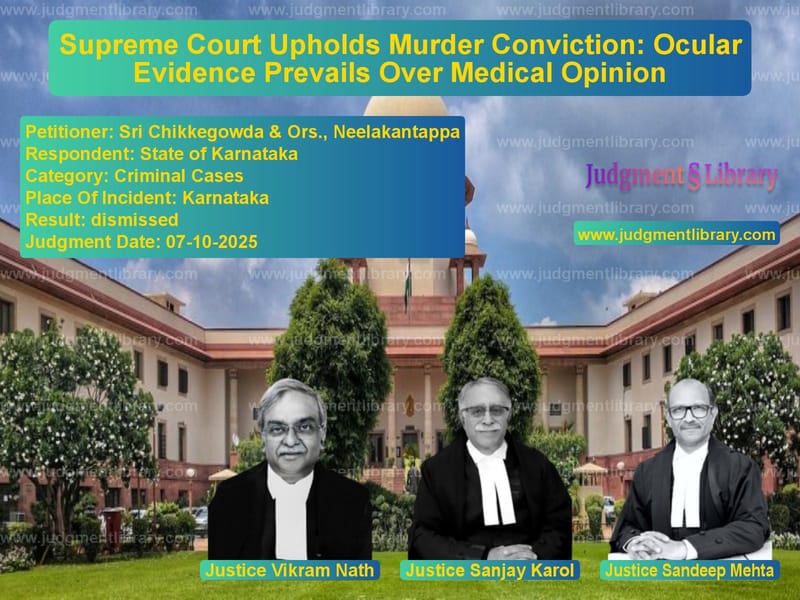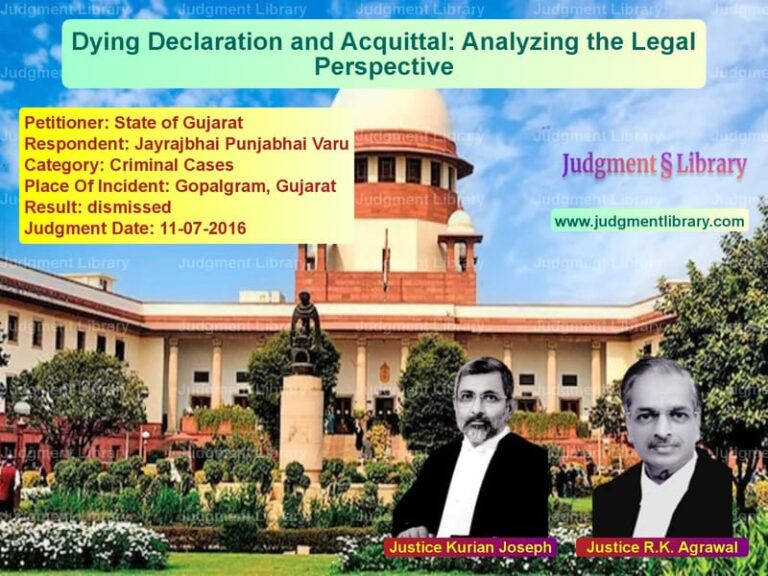Supreme Court Upholds Murder Conviction: Ocular Evidence Prevails Over Medical Opinion
In a significant criminal law judgment that reinforces the primacy of eyewitness testimony over medical evidence, the Supreme Court of India recently delivered a ruling that underscores the fundamental principles of criminal jurisprudence. The case involved a brutal murder that occurred in Karnataka, where sixteen accused persons were put on trial for the murder of Mohan Kumar and the assault on his wife, Smt. Annapurna. The legal journey of this case spanned over two decades, moving from the Trial Court’s acquittal of all accused to the High Court’s conviction of seven accused, and finally to the Supreme Court’s definitive ruling that brings closure to this long-standing legal battle. The judgment provides crucial insights into how courts should evaluate conflicting evidence and the weight to be given to the testimony of injured eyewitnesses.
The Tragic Incident and Initial Legal Proceedings
The case originates from a horrific incident that occurred on March 16, 2003, at approximately 6:00 a.m. in a Karnataka village. Mohan Kumar, the deceased, was carrying milk to the dairy when he was allegedly waylaid by sixteen accused persons who bore previous enmity with him. According to the prosecution, the accused blocked his way and assaulted him with dangerous weapons, causing fifteen injuries as per the post-mortem report. When the victim’s wife, Smt. Annapurna (PW-1), tried to save her husband and shield him from the assault, she too sustained life-threatening injuries. The accused fled the scene upon the arrival of other villagers.
The injured couple was first taken to the Primary Health Centre at Gandasi, where Dr. Sunil Kumar (PW-18) examined them and referred them to a higher medical facility due to the seriousness of their condition. They were then taken to J.C. Hospital at Hassan, where Mohan Kumar was declared brought dead, while his wife received treatment for her injuries. Importantly, while still at the Primary Health Centre, the police recorded the statement of PW-1, which formed the basis of the First Information Report.
The investigation that followed involved extensive evidence collection, including site inspection, recovery of weapons, recording of witness statements, and medical examinations. The prosecution presented a substantial case with twenty-three witnesses, thirty-three documentary evidence pieces, and thirteen material objects. However, the Trial Court, in its judgment dated September 13, 2010, acquitted all the accused, extending them the benefit of doubt.
The High Court’s Intervention and Conviction
Aggrieved by the Trial Court’s acquittal, the State of Karnataka and the informant filed appeals before the High Court. The High Court, after meticulous scrutiny of the evidence, delivered a common judgment on October 29, 2014, that partly allowed the appeals. The High Court confirmed the acquittal of eight accused but convicted seven accused (Accused Nos. 1 to 6 and 11) for offenses under Sections 143, 147, 148, 324, 302 read with Section 149 of the Indian Penal Code. The convicted accused were sentenced to life imprisonment under Section 302 read with Section 149 IPC, with lesser punishments for other offenses, all sentences to run concurrently.
The High Court identified several critical errors in the Trial Court’s reasoning. The Trial Court had primarily discarded the evidence of PW-1 based on two grounds: first, the medical evidence suggesting the time of death was between 3:00 a.m. to 4:00 a.m., contrary to PW-1’s statement that the incident occurred around 6:00 a.m.; and second, the defense theory that PW-1 was in an illicit relationship with PW-3 and had conspired to murder her husband.
The High Court found both these grounds untenable. Regarding the time of death, the High Court noted that the post-mortem report indicated death could have occurred 10 to 12 hours before the autopsy, which was conducted between 3:00 p.m. and 4:00 p.m. This timeframe comfortably accommodated PW-1’s version of events around 6:00 a.m. As for the alleged illicit relationship, the High Court found that the divorce proceedings of PW-3 had occurred in 1995, while PW-1’s marriage to the deceased took place in 1996-97, making the defense theory chronologically impossible.
The Supreme Court Appeal and Key Arguments
The convicted accused approached the Supreme Court, challenging the High Court’s judgment. The appellants’ senior counsel advanced two primary arguments. “Firstly, the High Court did not record any finding, nor arrive at a conclusion, that the view taken by the Trial Court in recording acquittal was not a probable view. In the absence of such a finding or conclusion, the conviction recorded by the High Court was palpably incorrect and contrary to the settled legal principles governing interference with a judgment of acquittal.” The counsel relied on precedents including Muralidhar alias Gidda v. State of Karnataka and Krishna @ Krishnappa v. State of Karnataka.
The second argument challenged the reliability of PW-1’s testimony. “The evidence of the injured/informant, PW-1, was unreliable and liable to be discarded. The Trial Court, after considering the material on record, had rightly concluded that the deposition of PW-1 was not worthy of reliance. The defense had created a clear dent in the prosecution story by setting up the plea that PW-1 and PW-3, along with their accomplices, were themselves involved in the murder of Mohan Kumar, the husband of PW-1, on account of their illicit relationship.”
The respondent-State of Karnataka vehemently defended the High Court’s judgment. The State counsel argued that “the High Court has dealt in detail about the patent fallacies committed by the Trial Court in recording the acquittal. It is clear from a bare reading of the judgment of the High Court that it had dealt with all the aspects and findings of the Trial Court, which it found to be perverse.” The State emphasized that “An injured witness, having sustained grievous injuries, would not falsely implicate others while leaving out the true assailants who had murdered her husband.”
The Supreme Court’s Legal Analysis and Reasoning
The Supreme Court bench comprising Justices Vikram Nath, Sanjay Karol, and Sandeep Mehta conducted a comprehensive analysis of the evidence and legal principles. The Court firmly rejected the appellants’ arguments and upheld the High Court’s judgment.
Addressing the first contention about the High Court’s approach to the acquittal, the Court observed that “The High Court meticulously dealt with the findings recorded by the Trial Court and, short of expressly stating that they were absurd, clearly found grave error in the reasoning given by the Trial Court. Even if the High Court omitted to write a single line stating that the view taken by the Trial Court could not have been a probable view, it would be unfair and unjust to hold that the judgment of the High Court could be faulted on this ground.”
The Court’s most significant analysis concerned the conflict between ocular and medical evidence. The Court powerfully reiterated the settled legal position that “if there is a conflict in the ocular testimony and the medical testimony/evidence, it is the ocular evidence which will prevail unless found to be totally unreliable.” The Court extensively relied on precedent, particularly citing Darbara Singh v. State of Punjab, where it was held that “So far as the question of inconsistency between medical evidence and ocular evidence is concerned, the law is well settled that, unless the oral evidence available is totally irreconcilable with the medical evidence, the oral evidence would have primacy. In the event of contradictions between medical and ocular evidence, the ocular testimony of a witness will have greater evidentiary value vis-à-vis medical evidence.”
The Court also cited State of U.P. v. Hari Chand, which held that “…In any event unless the oral evidence is totally irreconcilable with the medical evidence it has primacy,” and Pruthviraj Jayanthhai Vanol v. Dinesh Dayahhai Vala & Ors, which emphasized that “Ocular evidence is considered the best evidence unless there are reasons to doubt it…”
Applying these principles to the present case, the Court found that “From the testimony of PW-1, we do not find that she had faltered in any manner, or that her version in the examination-in-chief, which was fully in line with the First Information Report and her statement under Section 161 CrPC, could be said to have been impeached. During cross-examination, the defence could not elicit anything from PW-1 to render her testimony unreliable or worthy of being discarded.”
The Court particularly noted that “Interestingly, the defense did not put a single question to PW-1 challenging her injuries, the injury report, or even with regard to her alleged illicit relationship with PW-3. In such circumstances, the disbelieving and discarding of the testimony of PW-1 by the Trial Court was purely conjectural and unsustainable in law.”
The Court’s Final Ruling and Its Legal Significance
In its conclusive analysis, the Supreme Court found that “the High Court has taken a balanced view and has minutely scrutinized the evidence. It confirmed the acquittal of accused nos. 7, 8, 9, and 12 to 16, having found insufficient evidence to record their conviction. It also found insufficient evidence with respect to the charge of outraging the modesty of PW-1 and the charge of attempt to murder, holding that the injuries sustained by PW-1 were grievous in nature but not dangerous to life.”
The Court ultimately held that “For all the reasons recorded above, we find no ground to interfere with the impugned judgment of the High Court convicting the appellants.” The appeals were dismissed, and the appellants were directed to continue serving their sentences.
This judgment represents a significant reinforcement of fundamental principles in criminal jurisprudence. It reaffirms the primacy of ocular evidence over medical opinion, particularly when the ocular evidence comes from an injured eyewitness whose testimony remains consistent and unimpeached. The decision also underscores the appellate court’s authority to correct perverse findings of trial courts, ensuring that justice is not defeated by erroneous appreciation of evidence. By meticulously analyzing the evidence and applying settled legal principles, the Supreme Court has ensured that a brutal crime does not go unpunished due to technicalities or flawed reasoning, while simultaneously protecting the rights of those against whom evidence was insufficient.
Petitioner Name: Sri Chikkegowda & Ors., Neelakantappa.Respondent Name: State of Karnataka.Judgment By: Justice Vikram Nath, Justice Sanjay Karol, Justice Sandeep Mehta.Place Of Incident: Karnataka.Judgment Date: 07-10-2025.Result: dismissed.
Don’t miss out on the full details! Download the complete judgment in PDF format below and gain valuable insights instantly!
Download Judgment: sri-chikkegowda-&-or-vs-state-of-karnataka-supreme-court-of-india-judgment-dated-07-10-2025.pdf
Directly Download Judgment: Directly download this Judgment
See all petitions in Murder Cases
See all petitions in Attempt to Murder Cases
See all petitions in Bail and Anticipatory Bail
See all petitions in Custodial Deaths and Police Misconduct
See all petitions in Fraud and Forgery
See all petitions in Judgment by Vikram Nath
See all petitions in Judgment by Sanjay Karol
See all petitions in Judgment by Sandeep Mehta
See all petitions in dismissed
See all petitions in supreme court of India judgments October 2025
See all petitions in 2025 judgments
See all posts in Criminal Cases Category
See all allowed petitions in Criminal Cases Category
See all Dismissed petitions in Criminal Cases Category
See all partially allowed petitions in Criminal Cases Category







